PROPOSED CONCORD ECLIPSE FLIGHT 2001 PRIME
SCENARIO
Glenn
Schneider
Steward Observatory
University of Arizona
Flight Parameters:
Ground Speed: 2200 km/sec
Aircraft Altitude: 60,000 km/sec
Boundary Conditions/ Constraints:
Mid-Eclipse Intercept @ Minimum Umbral Veclocity -> 12:05:50
UT
Maximum Solar LOS Horizontal Deviation Angle = +/- 45°
-> 11:30:50 UT Intercept
No overflight of Angolan Airspace -> Break-off @ 12:35:50
UT (allows CIII heading realignment) - PROVISIONAL
Total Time for Eclipse Run: 4360 seconds
Total Distance for Eclipse Run: 2664.5 km
(does not include time/distance to/from Tenerife to intercept
and return)
Notes:
The scenario presented here is to be considered a design reference.
While a perfectly viable scenario, as is, details may vary after a review
by, and discussions with, Concord flight operations.
For early planning purposes lunar limb effects have been ignored, and computatiuons
performed quantized to the nearest 10 seconds.
Astrodymaic computations of the instantaneous topocentric times, positions,
velocities, orientation, etc. of the lunar umbra and aircraft positions
to define the intercept profile were performed by G. Schneider using proprietary
software developed specifically for this purpose from kernal routines which
have been used in planning 21 previous total solar eclipse observations.
Eclipse elements and circumstances were independently verified by separate
calculations performd by Fred Espanak (Goddard Space Flight Center).
Thanks, Fred.
Break-off time is provisional, and may have to be adjusted a few minutes
earlier to avoid a TBD buffer zone around Angolan airspace.
Eclipse Intercept Initiation - Second Contact Run@ 11:26:00
UT
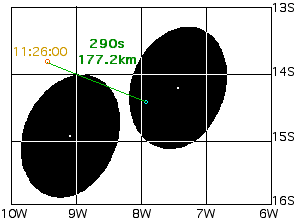
One hundred seconds before second contact, at 11:26:00
U.T (gold circle), the Concord will complete a heading alignment change
to a new heading of 112 degrees. This will alter its flight vector
from its outbound course from Tenerife to prepare for second contact.
Once on this heading the Concorde will fly through the second contact intercept
(a distance of 61.6km in 100 seconds, see next panel) to the point of centerline
run insertion at 11:30:50 UT (see third panel). A second heading change
at that time (90 seconds after second contact to 66.6 degrees) will put
the concord on the 1h05m long centerline run. The 4m50s second contact
run should allow ample time to acquire the sun in photographic instruments
before second contact. Remaining on this heading for an additional 190s
(116.1 km) will allow observation and recording of post-second contact
phenomena (edge prominences, chromospheric arc, etc.) before the required
heading alignment change. |
ECLIPSE INTERCEPT START @ 11:26:00 UT
CENTERLINE INSERTION INTERCEPT: 11:30:50 UT
CONSTANT GROUND SPEED: 2200 KM/HR
CONSTANT ALTITUDE AMSL: 60,000 ft.
AIRCRAFT HEADING: 112 Degrees
RUN START: 11:26:00 U.T.
AIRCRAFT LATITUDE: 13.8235S
AIRCRAFT LONGITUDE: 9.4486W
TIME TO MID-ECLIPSE: -2390 seconds
DIST TO MID-ECLIPSE: -1460.6 km
SHADOW LATITUDE: 14.9267S
SHADOW LONGITUDE: 9.0833W
SHADOW WIDTH: 183.7 km
SOLAR ALTITUDE: 47.8 degrees
SOLAR AZIMUTH: 25.0 degrees
AIRCRAFT HEADING: 112.0 degrees
HOR. LOS ANGLE +3.0 degrees
|
Second Contact @ 11:27:40 UT
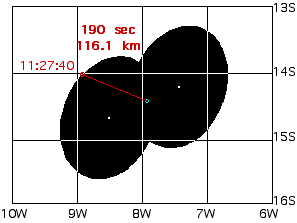 Flying on the approach to centrline injection, to achieve
a centerline intercept as shown in the previous panel, the Concord will
be flying at a heading of 112 degrees. This will place the sun nearly
"straight out" the window (horizontal LOS angle of +0.3 degrees) for optimal
viewing of the Contact II diamond ring (red circle) at 12:27:40.
The aircraft will fly 116.1 km in 190 seconds to reach the centerline intercept
(blue circle) at 11:30: 50 U.T. Shortly before (some tens of seconds
TBD) a heading alignment change to 66.6 degrees is required to begin the
centerline run. The details of the heading alignment arc will need
to be discussed with flight operations personnel.
Flying on the approach to centrline injection, to achieve
a centerline intercept as shown in the previous panel, the Concord will
be flying at a heading of 112 degrees. This will place the sun nearly
"straight out" the window (horizontal LOS angle of +0.3 degrees) for optimal
viewing of the Contact II diamond ring (red circle) at 12:27:40.
The aircraft will fly 116.1 km in 190 seconds to reach the centerline intercept
(blue circle) at 11:30: 50 U.T. Shortly before (some tens of seconds
TBD) a heading alignment change to 66.6 degrees is required to begin the
centerline run. The details of the heading alignment arc will need
to be discussed with flight operations personnel. |
SECOND CONTACT @ 11:27:40 UT
CENTERLINE INSERTION INTERCEPT: 11:30:50 UT
CONSTANT GROUND SPEED: 2200 KM/HR
CONSTANT ALTITUDE AMSL: 60,000 ft.
AIRCRAFT HEADING: 112 Degrees
CONTACT II: 11:27:40 U.T.
AIRCRAFT LATITUDE: 14.0264S
AIRCRAFT LONGITUDE: 8.9242W
TIME TO MID-ECLIPSE: -2290 seconds
DIST TO MID-ECLIPSE: -1399.4 km
SHADOW LATITUDE: 14.6683S
SHADOW LONGITUDE: 8.5050W
SHADOW WIDTH: 184.7 km
SOLAR ALTITUDE: 48.4 degrees
SOLAR AZIMUTH: 22.3 degrees
AIRCRAFT HEADING: 112.0 degrees
HOR. LOS ANGLE +0.3 degrees
|
Centerline Run Insertion - Completion @ 11:30:50 UT
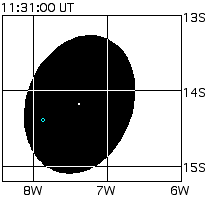 The location of the Concorde (blue circle) within the
topocentric projection of the umbral shadow at 60,000 feet (black ellipse)
is shown at 11:31:00 U.T., 10 seconds after completion of a heading realignment
onto the centerline. The geometric center of figure of the shadow
is noted (white dot). At this instant the shadow velocity is 2358
km/sec and decelerating. Relative to the shadow center the Concorde will
move slowly westward for 8 minutes (but remaining in the umbra) when, at
11:39: U.T. the shadow velocity equals that of the aircraft. At that
instant the Moon will appear stationary in the sky. The Concorde
will then begin to overtake the shadow and at 12:05:50 U.T. it will be
centrally located within it.
The location of the Concorde (blue circle) within the
topocentric projection of the umbral shadow at 60,000 feet (black ellipse)
is shown at 11:31:00 U.T., 10 seconds after completion of a heading realignment
onto the centerline. The geometric center of figure of the shadow
is noted (white dot). At this instant the shadow velocity is 2358
km/sec and decelerating. Relative to the shadow center the Concorde will
move slowly westward for 8 minutes (but remaining in the umbra) when, at
11:39: U.T. the shadow velocity equals that of the aircraft. At that
instant the Moon will appear stationary in the sky. The Concorde
will then begin to overtake the shadow and at 12:05:50 U.T. it will be
centrally located within it. |
INSERTION + 10 SECONDS
MID-ECLIPSE INTERCEPT: 12:05:50 U.T,
CONSTANT GROUND SPEED: 2200 KM/HR
CONSTANT ALTITUDE AMSL: 60,000 ft.
CLINE INTERCEPT + 10s: 11:31:00 U.T.
AIRCRAFT LATITUDE: 14.3923S
AIRCRAFT LONGITUDE: 7.8734W
TIME TO MID-ECLIPSE: -2090 seconds
DIST TO MID-ECLIPSE: -1277.2 km
SHADOW LATITUDE: 14.1817S
SHADOW LONGITUDE: 7.3750W
SHADOW WIDTH: 186.7 km
SOLAR ALTITUDE: 49.6 degrees
SOLAR AZIMUTH: 21.6 degrees
AIRCRAFT HEADING: 66.6 degrees
HOR. LOS ANGLE +45.0 degrees
|
Centerline Run Summary
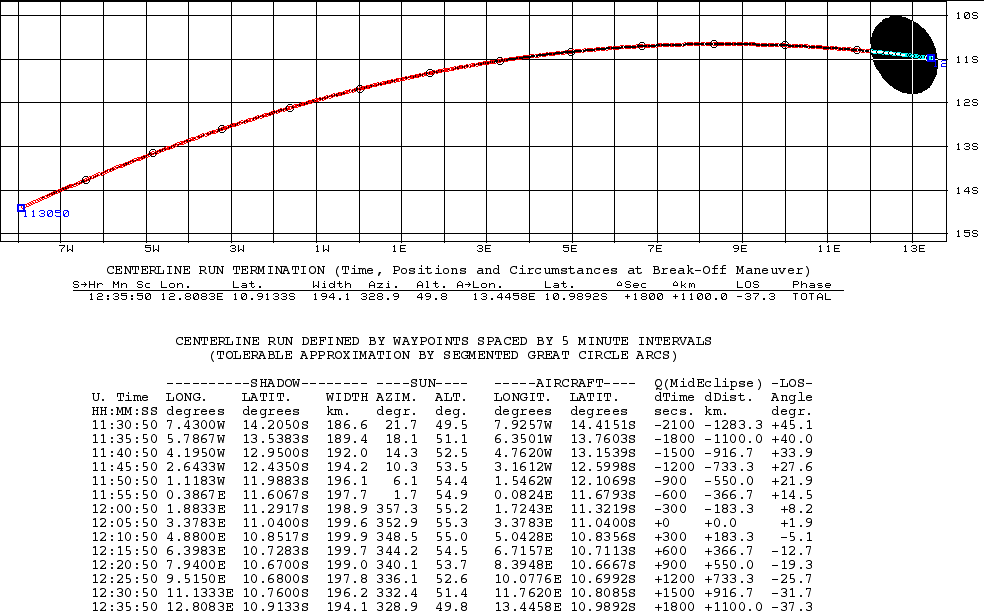
Centerline Run Simulation
| Click on the links to the right to view annimated
simulations of the centerline run from insertion at 11:30:50 UT to mid-eclipse
intercept at 12:05:50 U.T, and from mid-eclipse intercept to break-off
at 12:35:50 U.T. Here, mid-eclipse refers to the time at which the
Concorde is centrally located in the umbra, this is not temporally summetric
with the start and and off the centerline run. |
Insertion to Mid-Eclipse
Simulation
Mid-Eclipse to Break-off Simulation
|
Centerline Run Termination @ 12:35:50 UT & Third Contact
@ 12:38:40 UT
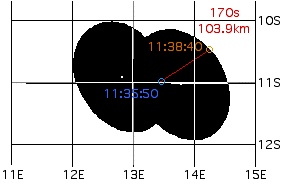 Because of the prohibition against flying at supersonic
speeds over Angolan airspace the Concorde must break off of the centerline
run while totality is still in progress. To assure this condition
not be violated a heading alignment maneuver to a new heading of 57.0 degrees
will be executed at 12:35:50 (provisional, but see table above for example).
Once on this new course, after 170s (distance 103.9 km) the Concorde will
leave the umbra at 12:38:40, and experience third contact with the sun
will be "straight out" the sun-side windows. This course will be maintained
for 30 seconds before a new heading is entered at pilots discretion to
return the Concord to Tenerife.
Because of the prohibition against flying at supersonic
speeds over Angolan airspace the Concorde must break off of the centerline
run while totality is still in progress. To assure this condition
not be violated a heading alignment maneuver to a new heading of 57.0 degrees
will be executed at 12:35:50 (provisional, but see table above for example).
Once on this new course, after 170s (distance 103.9 km) the Concorde will
leave the umbra at 12:38:40, and experience third contact with the sun
will be "straight out" the sun-side windows. This course will be maintained
for 30 seconds before a new heading is entered at pilots discretion to
return the Concord to Tenerife. |
THIRD CONTACT @ 12:38:40 UT
CENTERLINE BREAK-OFF : 12:35:50 UT
CONSTANT GROUND SPEED: 2200 KM/HR
CONSTANT ALTITUDE AMSL: 60,000 ft.
NEW AIRCRAFT HEADING: 39 Degrees
CONTACT III: 12:38:40 U.T.
AIRCRAFT LATITUDE: 10.4792S
AIRCRAFT LONGITUDE: 14.2415E
TIME TO MID-ECLIPSE: +1970 seconds
DIST TO MID-ECLIPSE: +1203.9 km
SHADOW LATITUDE: 11.0350S
SHADOW LONGITUDE: 13.7883E
SHADOW WIDTH: 192.7 km
SOLAR ALTITUDE: 48.8 degrees
SOLAR AZIMUTH: 327.0 degrees
AIRCRAFT HEADING: 57.0 degrees
HOR. LOS ANGLE +0.0 degrees
|
ALTERNATE SCENARIO - Long Duration CIII Diamond
Ring
A variation on the above theme with a planned mid-eclipse
intercept a few minutes earlier (toward the west) can give rise to a contact
3 diamond ring of exceptionally long duration. Indeed, the duration
of the CIII diamond ring can be tailored as desired, but traded off against
time fully within the umbra. In designing such a plan we are still
constrained by a viewing angle not to exceed 45 degrees from horizontal,
and no intrusion of Angolan airspace. No graphics have been generated
for this yet, but one proposition for a 4 minute long diamond ring is explained
here.
A) Intercept centerline at ~ 11:30:50 as before, BUT
with the aircraft slightly further down track (NE) at Latitude = 14.3520S,
Longitude = 7.7787W. This is for a mid-eclipse intercept at 12:01:30UT
(i.e., 1840 seconds, and 1124.4km after insertion onto centerline).
B) For a short while, as the shadow is moving faster
than the aircraft, the Concorde will move westward with respect to the
moving center of the shadow, but remain fully emmersed, until the umbral
velocity drops to 2200 km/hour.
C) Mid-eclipse occurs at 12:01:30 with the aircraft
and center of figure of the moon's shadow co-located at Latitude = 11.2550S,
Longitude = 2.0833E, with the LOS to the sun +7.3 degrees and an altitude
of 55.2 degrees.
D) Following this the aircraft, still overtaking the
umbra begins to approach the edge of the shadow.
E) At ~ 12:28:50 U.T. the concord should decelerate
from 2200 km./hr to 2131 km/hr over 10 seconds to reach this reduced speed
at 12:29:00 U.T.
F) At 12:29:00 U.T., the aircraft will be at Longitude
= 11.2987E, Latitude = 10.7717S (1650 seconds, and 1008.3 km, past mid-eclipse)
and will experience third
contact while co-moving at exactly the velocity of
the umbral shadow. At a heading of 93.6 degrees the diamond ring
will be "frozen" in the sky.
G) From this point the topocentric lunar velocity will
increase to 2199.3 km/second over the next 4 minutes (at 12:33:00 UT).
By slowly increasing the aircraft ground speed by 68 km/hour over this
4 minute period the diamond ring will continue to remain frozen in the
sky.
F) We can then continue on track for another two minutes
until 12:35:00 UT before executing a heading alignment maneuver to return
to Tenerife. At that time we will still be comfortably clear of the
Angolan coast by ~ 150 km.




